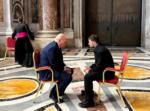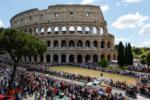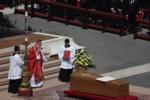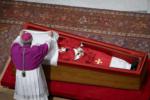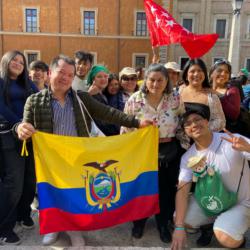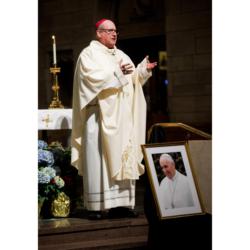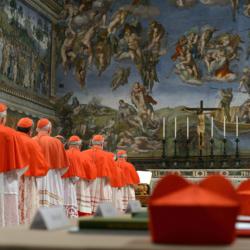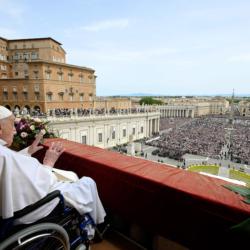Cambridge parish celebrates St. Anthony feast tradition
CAMBRIDGE -- The weather in Cambridge on June 9 was rainy and gloomy, but the clouds dispersed just in time for the annual procession that is the highlight of St. Anthony Parish's celebration of the feast of St. Anthony. Outside the church, beneath the blinding sun, hundreds of faithful prepared to march through the streets of Cambridge. Children dressed as saints and angels were showing each other which of their baby teeth they had lost, while girls in billowing white dresses were getting their hair done.
"Angels don't wear glasses," a woman explained to a young girl in a teal gown. "Can you imagine an angel wearing glasses?"
There were no angels wearing glasses, but one young saint was wearing a Paw Patrol wristwatch.
The church bells began to ring, and the parish marching band was warming up. It was a great day to celebrate St. Anthony of Lisbon -- better known as St. Anthony of Padua.
"The Italians claim him in Padua, and the Portuguese claim his birthplace, Lisbon," Father Michael Harrington, pastor of St. Anthony's, told The Pilot. "St. Anthony is a great hero of the people. It's not just Portuguese and Brazilians, but St. Anthony has touched all parts of the world."
St. Anthony's has celebrated the feast of its patron saint since the parish was established in 1912.
"Devotions are very particular to us as Catholics," Father Harrington said. "It's not just important for the Portuguese, but it's important for all Catholics to maintain devotions, to recognize the saints as intercessors before God."
The day's festivities began with a Mass celebrated in Portuguese by Father Jim Achadinha, pastor of the Catholic Community of Gloucester and Rockport. "Father Jim," as he is affectionately known, received all of his sacraments at St. Anthony's. He received a hero's welcome when he returned to the parish.
"St. Anthony was not simply effective because of his fiery words and Spirit-filled sermons," Father Achadinha said in his homily. "No, he was effective because his life exemplified the simplicity of the Gospel through the poverty of his Franciscan life and the integrity of his words and actions."
Father Achadinha said that St. Anthony was so significant because, at a time when many clergy lived "a rich and decadent lifestyle," St. Anthony provided an example of truly following the Gospel.
"St. Anthony brought a refreshing spirit of integrity and was able to transform many lives and help in the conversion of many under his care to return to the Lord," Father Achadinha said. "St. Anthony helps us to truly practice what we preach, to take up the cross with joy daily, and to witness to our faith, using words if necessary."
The Mass concluded with a hymn to St. Anthony.
After Mass, parishioners were treated to a banquet of traditional Portuguese foods: Salt cod, pork, liver, tripe, rice, beans, and, of course, plenty of malasadas.
The procession began after lunch. Men wearing red and gold sashes over their suits and women clutching rosaries marched slowly through the streets of Cambridge. Four men carried a float bearing a statue of St. Anthony, and four more carried a float bearing an image of Our Lady of Aparecida, the patroness of Brazil. Behind them, Father Achadinha blessed onlookers with a relic of the True Cross, protected under a gold and white canopy and surrounded by ornate silver lanterns.
Children peeked out from behind doors and fences to watch the procession move past their homes. Some of the houses were decorated with Portuguese azulejo tiles depicting saints. Girls in pristine white dresses and shoes were careful not to step on puddles. A chaperone watching three of the young saints had to tug them along using the red ribbon that connected the anchor, heart, and cross that each child was holding. People on scooters and bicycles swerved to avoid the procession.
Father Harrington said that the procession showcased "the great devotion of the Portuguese people" to St. Anthony.
"I think that's the key," he said. "We want to teach the next generations that devotion to St. Anthony and to the saints is very important."
During and after the procession, Rancho Folclorico Alto Minho de Norwood, a group dedicated to preserving Portuguese culture, performed a series of lively folk dances. Vibrantly-colored skirts spun around while musicians played concertinas that glittered in the sun. Henry Cerqueira played the raca, a guiro-like instrument that is played by sliding a wooden stick along a line of notches. Such instruments were played by the working people of Portugal to celebrate the arrival of the harvest each year.
"It was just a simple instrument to keep the beat," Cerqueira told The Pilot.
His instrument was anything but simple. Decorated with the carved head of a dancer, the raca was handmade out of chestnut wood by a craftsman in Boimo, the village that Cerqueira's great-grandfather came to Massachusetts from at the turn of the 20th century. Cerqueria's one-year-old granddaughter Valentina, also dressed in traditional Portuguese clothing, was particularly fascinated with the raca.
Cerqueira is strongly devoted to St. Anthony and Our Lady of Fatima and has passed both his faith and the art of Portuguese folk dancing to his children and grandchildren. He has a grandson on the way who will be named Anthony.
"It's to keep the culture together," he said, "to let the young people that were born here realize how much their parents and grandparents went through, and to try to keep in touch with their roots."
The feast concluded with eucharistic adoration and the traditional blessing and distribution of St. Anthony's Bread.


